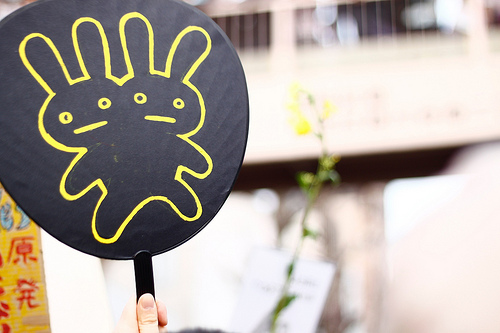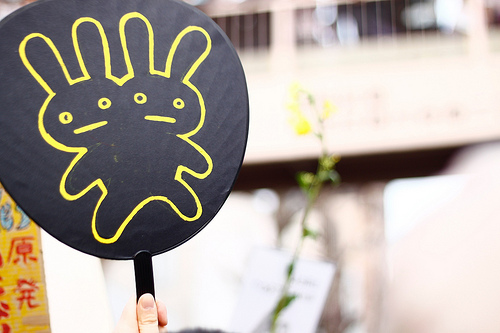 An anti-nuclear protestor in Japan gets creative.Photo: Matthias LambrechtThis post was originally published on TomDispatch and is republished here with Tom’s kind permission.
An anti-nuclear protestor in Japan gets creative.Photo: Matthias LambrechtThis post was originally published on TomDispatch and is republished here with Tom’s kind permission.
Last Monday, Yukio Edano, chief cabinet secretary, defended the Japanese government’s response to the nuclear disaster at Fukushima, insisting that the plant complex is in “a stable situation, relatively speaking.” That’s somewhat like the official description of 11,500 tons of water purposely dumped into the ocean waters off Fukushima as “low-level radioactive” or “lightly radioactive.” It is, of course, only “lightly” so in comparison to the even more radioactive water being stored at the plant in its place. But that’s the thing with descriptive words: they can leave so much to the eye of the beholder — and the Japanese government hasn’t been significantly more eager than the Tokyo Electric Power Company (Tepco), which runs the complex, to behold all that much when it comes to Fukushima.
On Tuesday, the government finally raised the Fukushima alert level on the International Nuclear Event scale from 5 to 7 — “a major accident” — the highest category possible, only previously used for the 1986 Chernobyl nuclear disaster (which resulted in a 15,000-square-mile “dead zone” in the Ukraine). Though government officials rushed to play down the Chernobyl comparison, a Tepco official offered this ominously bet-hedging comment: “Our concern is that the amount of leakage could eventually reach that of Chernobyl or exceed it.”
In fact, on our punch-drunk planet, we’ve never seen anything like what’s underway at Fukushima — not one but four adjacent nuclear reactors, three of which seem to have suffered partial meltdowns, and several containment pools for “spent” fuel (which, in terms of radioactivity, is anything but spent) in various states of distress. Meanwhile, talk about the weeks needed to bring the situation under control has faded into perilous months, years, decades, even a century of cleanup and recovery. There is speculation that some of the core of at least one reactor has already “leaked from its steel pressure vessel into the bottom of [its] containment structure” — and every action to bring the complex under some kind of control only seems to create, or threatens to create, other unexpected problems (like that “lightly radioactive” water).
Meanwhile, amid further giant aftershocks from the 9.0 earthquake of March 11 (with possibly years more of them to come), the Japanese government has been slowly widening the 12-mile “evacuation zone” (recently described by a visitor as an eerie “death zone … like an episode of Rod Serling’s Twilight Zone crossed with The Day After — an apocalyptic vision of life in the nuclear age”) around the complex. Just this week, it began warning pregnant women and children to stay out of certain areas up to 18 miles away from the plant. That’s not surprising, considering that in a small number of soil tests taken outside that 18-mile zone — in one case 25 miles from Fukushima — cesium-137 (half-life 30 years) has been found at levels that exceed those which, at Chernobyl, forced residents to move away. Many of the hundreds of thousands of Japanese who once lived in these areas (and if things get worse, beyond them) may never go home.
Whatever happens at Fukushima, could there be a more striking warning that we humans have been overreaching and that our planet has a way of offering penalties for such hubris? And keep in mind, the Japanese are hardly in this alone. After all, in the United States, at least five nuclear reactors are situated in “in earthquake-prone seismic zones,” according to a recent report, which doesn’t even include the Indian Point nuclear reactor built on an earthquake fault only 30 miles from downtown New York City, my hometown.
Perhaps it’s time to recalibrate when it comes to the way we’re treating planet Earth — before it’s too late.



